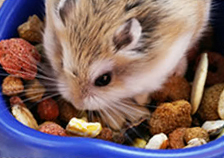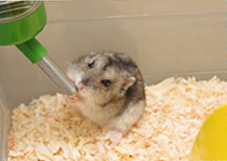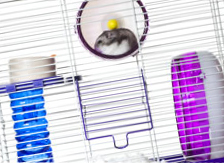Hamsters
Hamsters
Needs
Here’s a simple checklist to assist you in taking proper care of your hamster

- Cage
- Bedding
- Running wheel
- Chewing blocks (for trimming of teeth)
- Water bottle
- Food bowl
- Access to clean and fresh water
- Adequate and nutritious food
- Registered veterinarian consultation for regular checkups or medical treatment when the hamster is sick/injured
- Some of the diseases commonly found in hamsters are malocclusion, malnutrition or neoplasia
- If a hamster is not eating as usual, bring them to a vet as soon as possible
Above all, remember your hamster needs tender loving care!
Feeding
Hamsters are omnivores. This means their nutrition can come from plants and animals. Animal protein can come from invertebrates, cheese, boiled egg or meat. However, most of hamster’s nutrition can be well supported by plant protein, which is found in well-balanced commercial diet, grain, seeds and vegetables. In addition, a daily portion of mixed nuts, seeds, dried fruits and vegetables and small amounts of fresh fruits and vegetables such as apples, grapes, carrots, corn and green leafy vegetables are recommended. Hamsters can overindulge themselves with sunflower seeds. This can cause malnutrition.
Provide your hamster with food ad lib throughout the day. Hamsters will store food in their cheek pouches or hide food in a corner. Avoid feeding sharp or sticky food that could get stuck in or injure the hamster’s cheek pouches.

Supply your hamster with clean, fresh water at all times. Use a water bottle that can be hung on the cage. Be sure the tip of the water bottle is well-positioned for your hamster to reach easily. Change the water in the water bottle daily and wash the water bottle frequently.
Hamsters have teeth that grow continuously, so provide your hamster with a chewing block for it to chew and gnaw on to prevent overgrowth. You may need to bring it to the vet regularly so that the vet can trim your hamster’s teeth.

Accommodation
Give your hamster a big enough cage so that it has enough space to eat, sleep and exercise. Put the cage in a warm place indoors, out of direct sunlight. The cage should be secure to prevent escape and have solid flooring as wire flooring may hurt your hamster’s small feet. Put a nest box inside the cage so that your hamster can sleep inside the box in the day avoiding daylight and outside noises. As it is hamster’s nature to burrow, give your hamster little structures in the cage such as cardboard tubes and ladders. Give your hamster a running wheel so that it can exercise and play. Fix the wheel on the wall of the cage.
Line the cage with comfortable bedding which can absorb wet waste easily, such as those made from recycled paper or clean white kitchen paper. Dispose of soiled or wet bedding regularly. You should change all the bedding in the cage and wash the cage thoroughly weekly.

Cleaning and grooming
Most hamsters keep themselves clean and groomed with their saliva and paws. Therefore you do not need to bathe them. For long-haired hamsters, brush them daily and gently with a soft toothbrush to keep their fur free from tangles.
Interaction
Hamsters can live alone and are best by themselves. If you wish to keep two or more hamsters together, make sure they are of the same species, same sex and preferably from the same litter. This is because different species of hamsters do not get along. Also, if you put hamsters of different sex in the same cage, they will breed. You should confirm their gender with an experienced pet shop keeper or a veterinarian before purchase.
If you keep more than one hamster in a cage, provide them with adequate hiding places and toys and check them frequently to see if they have any fight wounds. If there are, you will have to separate them.
Hamsters are nocturnal, this means they are active at night and should be left alone to sleep during the day. Try not to disturb them while they are sleeping otherwise they may bite you. It is best to play with them in the evening.
When you first adopt your hamster, give it a few days to warm up and get used to you before you start holding it and playing with it. Once it gets used to you, spend time with it every day.
When handling your hamster, you should pick it up very gently using both hands and stay close to the ground or over a flat surface. Be extra careful, gentle, slow and steady when you hold your hamster so that it won’t get scared. Hamsters move very fast and may not like to be touched. They may bite, jump or fall if they are frightened or if they are not held properly or squeezed too tightly. It is important to establish bonding with your hamster.